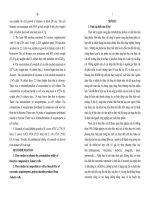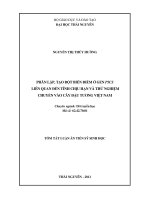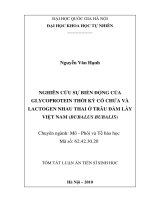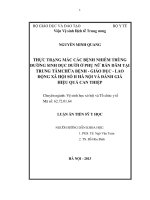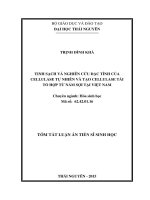3 luan an tien si sinh hoc sinh san bao ngu 2000
Bạn đang xem bản rút gọn của tài liệu. Xem và tải ngay bản đầy đủ của tài liệu tại đây (6.85 MB, 265 trang )
Reproductive Biology and Seed Production of the
Tropical Abalone Haliotis varia Linnaeus (Gastropoda)
THESIS SUBMITTED
IN PARTIAL FULFILMENT OF THE REQUIREMENTS
FOR THE DEGREE OF
'Doctor of Plii£osopfty
IN MARICULTURE
OF THE
CENTRAL INSTITUTE OF FISHERIES EDUCA TION
(DEEMED UNIVERSITY)
VERSOV A, MUMBAI - 400 061
'By
T.M. NAJMUDEEN
CENTRAL MARINE FISHERIES RESEARCH INSTITUTE
(INDIAN COUNCil OF AGRICULTURAL RESEARCH)
P.B. NO: 1603, KOCHI- 682014
INDIA
SEPTEMBER 2000
Reproductive Biology and Seed Production of the
Tropical Abalone Haliotis varia Llnnaeus (Gastropoda)
THESIS SUBMITTED
IN PARTIAL FULFILMENT OF THE 'REQUIREMENTS
FOR THE DEGREE OF
tIJoctor o!Pfii[osopfiy
IN MARICUL TURE
OF THE
CENTRAL INSTITUTE OF FISHERIES EDUCATION
(DEEMED UNIVERSITY)
VERSOV A, MUMBAI - 400 061
13y
T.M. NAJMUDEEN
CENTRAL MARINE FISHERIES RESEARCH INSTITUTE
(INDIAN COUNCIL OF AGRICULTURAL RESEARCH)
P.B. NO: 1603, KOCHI- 682014
INDIA
SEPTEMBER 2000
CENTRAL MARINE FISHERIES RESEARCH INSTITUTE
(INDIAN COUNCIL OF AGRICULTURAL RESEARCH)
\lTC¥~
ICAR
Dr A.C.C. Victor
Tuticorin Research Centre of
CMFRI, Tuticorin-l
Senior Scientist
CERTIFICATE
This is to certify that the thesis entitled "Reproductive biology and
seed
production
of
the
tropical
abalone Haliotis
varia
Linnaeus
(Gastropoda)" is an authentic record of the research work carried out by
Mr. T.M. NAJMUDEEN under my scientific supervision and guidance at
Central Marine Fisheries Research Institute, Kochi, in partial fulfilment of the
requirements for the degree of Doctor of Philosophyof the Central Institute of
Fisheries Education (Deemed University), Mumbai, and no part thereof has been
presented for the award of any other degree, diploma or associateship in any
University.
~
Kochi - 682 014.
September, 2000.
DR A.C.C. VICTOR
(Supervising Guide)
DECLARATION
I, T.M. NAJMUDEEN, do hereby declare that this thesis entitled
Reproductive biology and seed production of the tropical abalone Haliotis
varia Linnaeus (Gastropoda) is a genuine record of the research work done by
me under the scientific supervision of Dr A.C.C. VICTOR, Senior Scientist, TRC
of CMFRI, Tuticorin, and has not previously formed the basis for the award of
any degree, diploma or associateship in any university.
Kochi - 682 014
September, 2000.
I
\\))~"
, . .-I~
_,,-'
T.M. NAJMUDEEN
ADVISORY COMMITTEE
Chairman & Major Advisor: Dr. A.C.C. Victor
Senior Scientist
Tuticorin Research Centre of
Central Marine Fisheries Research Institute
Tuticorin-l
Co- Chairman
Dr. P.C. Thomas
~ (Y'-fl ~
Senior Scientist
Central Marine Fisheries Research Institute
Kochi-14.
Members
Dr. K.K. Appukkuttan
Head, Molluscan Fisheries Divison
Central Marine Fisheries Research Institute,
Kochi- 14.
Mr. D. Kandasami
Senior Scientist
Madras Research Centre of
Central Marine Fisheries Research Institute
Chennai- 06
Mr. K. Narayana Kurup
Senior Scientist
Central Marine Fisheries Research Institute
Kochi-14.
ACKNOWLEDGEMENTS
I liadgreat privilege to wor/t under tlie a6fe guid'ance of(/)r }l. C. C. Victor, Senior
Scientist, 'l'1?.C of C9IffF(jlj, q'uticorin. I
ta~
tliis opportunity to express my deep sense of
gratitude for suggesti11{J tFiis pr06fem andfor givi11{J me inva{ua6fe guid'ance witFi constant
encouragement.
I am gratefu{ to my advisory committee mem6ers, (/)r CP. C. rzTiomas, Senior
Scientist, 9rlr. 1( Narayana /turup, Senior Scientist, (])r 1( 1( )lppu/t/tuttan, Jfead, ::MP(/),
C::MPCJ?j, 1(oclii and::Mr. (j). 1(andasami, Senior Scientist, ::M1?.C of C::M P(j{I, ::Madras for tlieir
sincere lie[p offered me during tlie course of my wor~
Witli mucli gratitude I tlian( (])r 0/. 1(ripa, Senior Scientist, ::MP(/), C9rlPCJ?j,
1(ocFii, for critica{{y correcting tFie manuscript ana for providing va{ua6fe suggestions. 7Fie
guid'ance
of (/)r Jl.
qopafa/trisFinan, Senior Scientist,
mpq~
CocFiin
Ce~
is a[so gratefu{{y
ac/tnowfedfJetf.
I am FiigFi(y inde6ted to 9rlr. {}306y Ignatius, Scientist, ::Mr. 9rl. {}3adarutfeen,
former rr'eclinica{ Officer and ::Ms. Preetlia Pani/(/tar, Scientist, 9rl1?.C of C::MPCJ?j, ::Matufapam,
for tFieir unfaiung cooperation and advice tFirougFiout tFie period of my wor~
It is my privifege to express my Fieartfe{t tlianR.§ to 9rlr. :JV.1(
Sana~
Scientist,
(])r. 1( CR,gngarajan, former Senior S~ntist, Mr. 9rl. jIyyappan Pilfai, q'ecFinica{ Officer atuf
9rlr. 1?g.gFia'Van, PFiotograpFier, C9rlP(j(j, 1(ocFii, for tFieir Fie(p in carryi11{J out f£fectron
microscopic studies.
lowe tlie deepest sense ofgratitude to (j)r Pau{ (j{aj, Officer -in-cliarge, atuf(j)r C.
Susee{an, former Officer-in-Cliarge, Pq(]!
I wisFi to record my sincere tFianR.§ to 9rls (j@sa{ie SFiaffer, rr'ecFinica{ Information
Specia{ist, NOjIjI, 1fMPS, Panama City £i6rary, P[orida, VSjI for lier quic/t response to_ my
request for 'Va{ua6fe uterature. I a[so express my tFia:nR.§ to (/)r jI. 9rloFiandas, Professor, Sclioo{
of f£nvironmenta{ Studies,
CocFiin Vni'Versity
ofScience atuf rr'eclino[ogy, for providing me tlie
faciuty to ta~ pliotograpFis of Fiisto[ogica{ sections.
I also remem6er 'Witli gratituae, tlie assistance of:Mr. 0/. Satliyanesan, Senior
Li6rary ;4.ssistant, :MCR..C of C:MP1ij; :Mandapam, wliose lie(p ena6fea me to utifize tlie
facifities of tlie fi6rary at :M.CR..C of C:MP1ij. fJ1ie fie(p renaerea 6y my friend:Mr. 1(:M. (])avid,
;4.rtist, :MCR..C of C:MP1ij auring tlie fina{ stages of tlie tliesis also gratefu{{y aJk_nowfetfgecf.
Specia{
tlian~
are also aue to :Mr. CJ>.J. (])ams ana:Mr.
rr.N.P.
1(urup,
JIdministrative section, C:MP1ij, for tfieir encouragement and affectionate advice tfirougliout
tlie course of tlie wor~
I am incfe6tea to tlie divers, :M.r. Seeni at
?drJ
of C:MP1lj,
:M.r. Se/tliar,
:Mr. :Mutliuk_rishnan ana:Mr. rtesuraj at rtCR..C of C:MPCRj, for tlieir sincere lie(p auri1lfJ tlie
coffection ofspecimens.
of gratituae to my frienas ;4.6raliam, C:MPCRj, 1(oclii,
Schoof of ?darine Sciences, CVSJIrT, 1(oclii, whose constant
I e:{press my aeep sense
Joyaas ana rv'inu Chanaran,
encouragement, and sincere he(p ena6fed me to compfete tlie wor/t 'Witli mucfi more confidence.
71ian~
are also aue to my frienas at C:MPrJ?j, 1(am ?dohan, Soniraj, Satish Saliaya~ fl_ni{
1(umar,
Jayagopa~
J[aneefa 1(oya, (Ba{u, :M.anoj, 1(anjitli, Vnni/trisfinan, (Binu ana ([Tasanth
ana a{{ my c{assmates anafriends at C:MPCRj ana Cochin Vniversity, who helpea me auring
the course of the wor~
71ie lie(p renaerea 6y :Ms Jyotlii :Menon is also gratefu{{y
ac/tnowfecfgecf. I gratefu{(y remem6er the encouragements given 6y tlie teachers at Schoof of
:A1.arine Sciences, Cochin Vniversity.
lowe much cfe6t
of gratitude to
my friendS at :MrJ
of C:MPCRj,
:Manaapam,
flnatuf, JInanaan, 1(ajan, Xavier, (jJiju, ana CJ>aamana6ha for their he(p ant! cooperation auring
my wor/t at :M(j(C of C:M PCRj.
I ta~ tliis opportunity to than/(!Mr. ;4.. Che{Cam, :Mr.
([J.e. 0/.
P,asterson atuf
of C:MPCRj for their he(p ana cooperation during tfie
am very mucfi ind'e6ted to (])r rr. Su6ramoniam, CJ>rofessor, (])epartment of Zoo{ogy,
:Mr. (])hannaraj, Senior Scientists, rtrJ
I
!Mcu[ras Vniversity, for the he(p renaerea me for the interpretation of efectron micrographs.
I ac/tnowfetfge (])irector, 'C:MP1(I, 1(oclii for providing the necessary facifities
ana Indian Counci{ ofJIgricu{tura{ CRgsearcli for Senior CRgsearcli Pe{{owsfiip.
JI60ve a{{ I
e~ress
my gratitucfe to a{{ my fami{y mem6ers, my [ate fatlier,
motlier, 6rothers, sisters -in-Caw ana sisters, for tlieir unfaifing support witliout wliicli this
work_couU not liave materiafizecf.
CONTENTS
Page Nos.
Chapter I
GENERAL INTRODUCTION
Chapter II
REPRODUCTIVE BIOLOGY
1
INTRODUCTION
11
MATERIALS AND METHODS
22
RESULTS
1. Description of the gonad
29
2. Classification of maturity stages of the grfa'd
30
3. Gonadosomatic index
35
4. Sex ratio
36
5. Size at first sexual maturity
36
6. Fecundity
37
7. Hepatosomatic index
38
8. Progression of ova towards maturity
38
9. Mechanism of spermatogenesis
39
10. Mechanism of oogenesis
44
11. Annual reproductive cycle
50
12. Hydrographic conditions of the collection sites
55
DISCUSSION
58
~
Chapter III
BIOCHEMICAL CHANGES IN RELATION
TO GONAD MATURATION
INTRODUCTION
82
MATERIALS AND METHODS
88
RESULTS
Chapter IV
1. Biochemical changes in the foot
93
2. Biochemical changes in the digestive gland
94
3. Biochemical changes in the gonad
95
4. Statistical analysis
96
DISCUSSION
97
SEED PRODUCTION
INTRODUCTION
107
MATERIALS AND ME1HODS
114
RESULTS
Chapter V
1. Brood stock management
118
2. Spawning inducement and fertilization
118
3. Hatching
120
4. Larval rearing
120
5. Larval stages ofH varia
120
6. Inducement of settlement and metamorphosis
122
7. Diatom culture
124
8. Juvenile rearing
124
DISCUSSION
126
SUMMARY
134
REFERENCES
140
Chapter I
GENERAL INTRODUCTION
Chapter I
INTRODUCTION
The vast expanse of ocean has often been seen as a limitless source of animal
protein for mankind. As this source is depleting in recent years due to more intense
fishing pressure, maritime countries have given priority to aquaculture development
with the objective of preserving and increasing their natural resources. The expansion
of culture industry of any species chiefly relies on an improved understanding of the
biology of the species, particularly on spawning characters.
Dependence on the
natural seed resources for culture is risky because it is extremely variable in quality
and quantity and off-season availability.
So artificial seed production is the only
alternative for the expansion of aquaculture especially when the distribution of the
specie~
is limited. Diligent work by fishery scientists in many parts of the world is
bringing the reproductive process and seed production of more organisms under
control.
Molluscs are one of the most compact groups of animals with more species
known from marine environments than of any other animal phylum.
In number of
species, the mollusca are the second phylum to the Arthropoda" comprising about
8C1000 species. A major part of the world marine aquaculture production is made up of
molluscs including clams, cockles, oysters, mussels, scallops and abalones.
In
aquaculture production, molluscs are the third largest commodity in the Asia-Pacific
region providing about 16% of the total. Three quarters of molluscs are gastropods
with about
~650
genera. Gastropods are among the most conspicuous sea animals,
and species of limpets, snails and slugs are found in all the marine habitats. Members
2
of this class have one shell, as opposed to clams and oysters with two. The most
valuable gastropod from an epicurean point of view is certainly the abalone.
Abalones, commonly known as ear shell, are economically important
marine gastropods belonging to the genus Ha lio tis. There are about 100 species of
abalones in the world.
They are fou~d in. both the hemispheres, but the larger
varieties exist in the temperate regions, while the smaller ones live in tropical and
arctic regions. Because these animals have been of commercial value since ancient
times, much has been written about their natural history beginning with Aristotle
(Crofts, 1929).
The first fisheries of abalone were in China and Japan over 1500
years ago, but it is only in the last 30 years that the fisheries for abalone have
burgeoned worldwide and become economically important in many countries.
Abalone meat is highly priced and contains about 20%
protein. They
have blue-gray mother-ot-pearls that can be made in to several types of ornaments. It
is considered to be one ot the best and most valuable seafoods in various parts of
Asia. Abalone is valuable as an ingredient in Chinese medicine (Guo et al., 1999).
The viscera can be made into good quality glue.
produce pearls.
Abalones can also be used to
The first recorded reference to abalone pearls occurs in one of
Japan's oldest historical writings (Shirai, 1970). The nacre of abalone shell is often
multihued in tones of silver, orange, pink, green, blue and lavender. The colour play
tends to be very beautiful in these pearls since the nacre that is produced by abalone
is thick and can reflect the full spectrum of rainbow colours. The quality of abalone
pearls as reflected in their surface texture, is superior to the pearls produced in fresh
water mussels and comparable to the best pearls cultured in marine pearl oysters
(Pinctada sp.).
3
Cultivation of abalone has spanned nearly a 50-year period. Pioneering efforts
to cultivate North American Haliotids began in 1940 (Carlisle, 1962).
The 1970s
witnessed a continued interest in red abalone cultivation in California. In 1972, there
were only two nations studying abalone aqu.aculture. Improvement of hatchery and
culture technology, and expansion of culture area has continued since this time.
Consequently abalone aquaculture has rapidly developed and production has greatly
increased, particularly in Taiwan and Japan. Japan is at present the acknowledged
leader in developing techniques for the mass production of juveniles.
Although large abalones are very popular ·in many Asian countries, small or
cock ...tail size abalone of 40-70 mm shell length are also popular in some countries.
Chen (1989) states that in Taiwan, small abalones are preferred to large species
owing to their delicate flavour, appropriate size for banquets and price.
The total world production of abalones through aquaculture has increased in
1997 to 2484 tonnes from 2179 tonnes in 1996 (FAO, 1999).
China and Taiwan
contributed to around 89% of the total abalone production. USA contributed 265 mt to
the world abalone aquaculture production in 1997. Haliotis discus hannai is the
primary abalone species supporting abalone culture industry around the globe
accounting for more than 70 % of the world abalone aquaculture production.
The pearl culture in abalone appears to be a fairly recent enterprise. Unlike
oysters, cultivating pearls in abalone is extremely difficult. The pearl nucleus is
attached to the inside of the shell in a way in which the abalone will coat the nucleus
with nacre, the pearl secretion, without being able to expel it. There is a great chance
for the rejection of the nucleus by the some times violent movements of abalone's
large foot.
4
As the culture of round pearls in abalone met with only partial success due to
the nucleus dislodgement and infections precipitated by the muscular foot, most
farmers are now attempting to culture both 'mabe' and 'blister' pearls in abalone. A
mabe pearl is a dome shaped pearl cut from the shell around the pearl's perimeter. A
blister pearl is cut from the shell, leaving some of the surrounding shell to accent the
pearl.
With abalone pearls, this mother-of-pearl border can add greater variety of
'colours and create a very interesting gem.
The red abalone, Haliotis rufescens is the largest of the abalones in the world,
often reaching lengths greater than 27.5 cm and weighing over 1.7 Kg. Red abalone
has traditionally been the most popular and commercially important species in
California. The other important species in North America include H. fulgens (green
abalone), H. corrugata (yellow abalone), H .. sorensini (white abalone), H. cracherodii
(black abalone) and H. kamtschatkana (pinto abalone). Ezo awabi. (H. discus hannai)
found in Japan, is probably the most thoroughly studied abalone species in the world
growing to between 18 and 20 cm in shell length. The other species found in Japan
are H. discus (kuro awabi), H. diversicolor supertexta (tokobushi) and H. gigantea
(madaka).
H. ruber is the major Australian abalone species with H. laevigata and
H. roei. H. tuberculata or ormer is the only commercial species in Europe. H. midae
represents abalones in South Africa.
Unlike the temperate species mentioned above, the tropical abalone species
are smaller in size and less in abundance.
The major tropical abalones are
H. diversicolor supertexta, H. asinina, H. ovina and H. varia.
enjoys distribution in Japan, Thailand and Philippines.
Of these, H. asinina
The other two species are
5
abundantly distributed along the Andaman Sea coast of Thailand.
All the tropical
abalone species grow less than 10 cm in shell length.
While abalones occur in many parts of the world, the species large enough to
support commercial fishery are found along temperate coasts. The natural history of
abalone facilitates over fishing, and this has been a problem in every abalone
producing country. In Indian Ocean, abalones are found fr9m the Arabian Sea and
the Persian Gulf to the Bay of Bengal around Andaman and Nicobar Islands as well as
near Sri Lanka. In India, abalone is represented by only one species, Haliotis varia. It
grows to a maximum shell length of 80 mm. It is moderately distributed in Gulf of
Mannar along Pam ban and Tuticorin areas· of Southern Tamil Nadu. Hornell (1917)
states that abalones (Haliotis) , which are highly valued in other parts of the world and
occurring there in great abundance are scarce and of small size in India, making it
unnoticeable by the fishermen and researchers.
But owing to the importance of
abalones in world aquaculture scenario, it is important to initiate research on the
abalones in India.
Aquatic animals exhibit a wide variety of reproductive strategies; however,
virtually all the important aquaculture species rely on some form of sexual
reproduction.
Successful aquaculture is often dependant on the ease with which
culture animals can be reproduced in captivity.
Like:wise, the knowledge on the
breeding cycles of wild abalones is vital to the management of culture operations.
Unless captive spawning and rearing are achieved, the culturist has little or no control
on the genetic make up of the stock and is thus unable to attempt to improve the
characteristics of the animals through selective breeding.
Seed production is the
major turning point in the domestication of animals assuring the opportunity to
6
culturists to produce animals at a higher rate than that can be produced in the wild.
Success in captive spawning and larval rearing has been achieved for the majority of
the abalone species under culture today.
The termination of the planktonic stage of larvae is the most critical event in the
life history of abalones. The transformation from abalone larva to juvenile involves two
distinct processes: Settlement and metamorphosis (Crisp, 1974).
Settlement has
been described as the behaviolal change typically characterized by the active
searching for certain environmental factors such as specifics, prey species, algae and
inorganic cations (Hadfield, 1984).
It is a reversible event that may occur several
times prior to metamorphosis. Metamorphosis is a non-reversible phenomenon that
involves dramatic anatomic and physiological changes in larvae, ultimately yielding
juvenile individuals. Larvae of the red abalone, Haliotis rufescens has been shown to
settle and metamorphose in response to a number of biological substrates (Morse, et
al., 1979a, 1980b; Seki and Kan-no, 1981 a,b; Morse et al., 1980; Slattery, 1992).
Larvae of many species of Haliotis attach to the substratum and metamorphose in the
presence of benthic diatoms and conspecific mucus (Seki and Kan-no, 1981 a:
Slattery, 1992).
The purpose of the present study is to investigate the mechanism of
gametogenesis and to determine the annual reproductive cycle of Haliotis varia from
the.
.
Gulf of Mannar, A South East Coast of India. An effort is done to demonstrate that the
seed production of H. varia can be achieved in controlled conditions. The thesis is
presented in five chapters.
The first chapter is an introduction, highlighting the
importance of abalones and the present work. The taxonomic position of Haliotis varia
also mentioned along with its habitat description and distribution.
GJ4.5
7
In the second chapter the reproductive biology of H. varia is described with the
help of light and electronmicroscopic studies. Various procedures such as calculation
of sex ratio,
gonadosomatic index, fecundity,
size at first sexual maturity,
hepatosomatic index and the construction of oocyte size frequency profiles are
employed to study the reproductive biology and annual reproductive cycle of H. varia
at two stations; Tuticorin and Mandapam in Gulf of Mannar.
The information on
variations in the hydrographic parameters like salinity, temperature, pH and dissolved
oxygen in the two stations is also presented ..
The process of gonad maturation is often associated with the accumulation of
nutrients in the storage organs and its subsequent mobilization to the gonad. The
knowledge on the variations in different biochemical components in different tissues of
the animal during that period will be helpful in determining the annual reproductive
cycle. Hence an attempt is made to reveal the pattern of movement of biochemical
parameters during the maturation process of H. varia using various biochemical
procedures and it is presented in Chapter III.
In the fourth chapter, the seed production of H. varia, which was achieved in
controlled conditions in the laboratory, is documented with the help of photographs of
different larval stages. The larval rearing and the successful inducement of settlement
and metamorphosis of larvae of H. varia are described in detail.
The thesis is concluded by giving a summary of the work done in chapter V
followed by the list of references cited in the text.
8
THE SYSTEMATIC POSITION OF THE ABALONE STUDIED
Phylum
: Mollusca
Class
: Gastropoda
Subclass
: Prosobranchia
Order
: Archaeogastropoda
Superfamily: Pleurotomariacea
Family
: Haliotidae
Genus
: Haliotis
Species
: varia
Generic characters: Shell ear shaped, depressed and loosely coiled. Spire eccentric
and protruding only a little or not at all. A spiral row of holes on the left side of body
whorl, sometimes on tubular projections, the last few remaining open. Aperture broad,
occupying most of the under side with a remarkably thickened inner lip.
Interior
nacreous, with a big sub central muscle scar. No operculum. Head with a short snout
and large rounded tentacles bearing eyes on short lateral stalks of their outer bases.
Foot broad and ovate, very strong.
A sensory ridge along the edge of the foot,
bearing a series of tentacles. Two gills, the right one slightly reduced in size.
Food: Abalones eat marine algae. The adults feed on loose pieces of algae drifting
with the surge of the current. Large brown algae such as giant kelp, bull kelp and elk
kelp are preferred in temperate regions, although most others may be eaten at various
times. Abalone tends to stay at one location waiting for food to drift by. However,
they will move daily, seasonally or when food become scarce for a longer period. The
colour binding on many abalone shells is due to the changes in the types of algae
eaten. Juvenile abalone graze on rock encrusting coralline algae and on diatoms and
bacterial films. As they grow, they increasingly rely on drift algae.
9
Haliotis varia linnaeus 1758
Synonyms: H. coccinea Reeve, 1846; H. semistriata Reeve, 1846; Sanhaliotis varia
(Linnaeus, 1758).
Common names: Variable abalone, sea ear, tropical abalone.
Vernacular names: Tamil- Kadal kaathu, Thulkachi kaathu. Malayalam- Kadal chevi.
Species characters: Shell thick, elongate-ovate in out line, rather inflated, not keeled
in periphery of left side. Outer sculptur@ extremely variable, comprising irregular radial
folds crossed by low, rounded spiral ribs of different thickness, some of them weakly
knobbed. Periphery of left side with a few nodulose spiral cords. Holes rounded to
oval, on slightly elevated tubercles, the last four or five holes open. Ridge of inner lip
well developed, its posterior part hiding the internal coils of spire. Outer lip regularly
convex. Inner side of shell is somewhat reflecting the variable outer sculpture, muscle
scars sometimes well developed (FAO, 1998).
Habitat:
Among rocks and under stones, in rocky shores and coral reef areas.
Littoral to shallow subtidal depths.
Distribution: Wide spread in the Indo West Pacific, from East Africa, including the
Red Sea to Malaysia; north to Japan and south to southern Queensland; and along
the Andaman Sea coast of Thailand. In India distribution restricted to Gulf of Mannar,
on the South East coast of Tamil Nadu.
Description of the study areas: The collection sites Tuticorin and Mandapam belong
to the southern Tamil Nadu and is situated along the coast of Gulf of Mannar,
separated by a distance of about 140 kilometers (Plate II and 1111) Tuticorin is situated
at a latitude of
oao 45' N and longitude of 78° 12' E. Here the abalones are attached to
the granite stones along the coral bed inside the harbor basin (Plate VI1). The wave
10
action in this area is moderate. The Mandapam collection site is situated at longitude
09° 16' N and longitude 79° 12' E. The abalones are distributed along the 'paars'
behind the Krusadi, Pullivasal, Poomarachan and Manauli islands (Plate VI2). Unlike
Tuticorin station, here the wave action is strong. Abalones are found to attach to the
dead corals and in the crevices of coraf stones.
PLATE I
LENGTH
'--4
Plate. Diagram of abalone shells showing various measurements
0
0
z
<[
0°
>"
zZ
<[:3
~
~-
..J
..J(J)
4
:::.:::
<[
..J
z
«
t-z
t-<[
u
a.~
::;::;
00
zz
<[<[
...J ~
~ -0
:::t:
C)<[
ex<[
:J ::E
:::t:a:
::>
0
0
~~
_,
a. u.
_;C\i ,,; ~
(J)~
a..
z
z
<[
~
w
..JO
_J
..J
0
:;:)..J
a
Z
<[
_J
~
w
~~
a:
<[
:::t:
IOU:;
,...:
0
om
I'-
0
~
~
0
~
=
W
~
a.
•
Chapter II
REPRODUCTIVE BIOLOGY
1. Introduction
2. Materials and Methods
3. Results
4. Discussion
11
Chapter II
REPRODUCTIVE BIOLOGY
INTRODUCTION
Detailed information on the reproductive biology of the cultured species is vital
to the culturist enabling him to rear them under most favourable conditions to achieve
maximum success in induced maturation and spawning. This information can be used
to design efficient and effective techniques for conditioning, spawning inducement,
larval development and settlement.
Studies on reproduction are also useful in
formulating fishery management regulations for commercial species. Knowledge of
breeding seasons is essential for the estimation of growth rates, particularly of young
stages. The relationship between age, fecundity, and the minimum size at maturity
must be taken into account when minimum fishable size is determined.
Reproductive pattern in archaeogastropods is of broadcast spawning in which
mature sperms and eggs are released into the surrounding media without any
secondary modification.
Among Prosobranch molluscs, the simplest reproductive
system is encountered in archaeogastropods (Giese and Pearse, 1977).
The
reproductive system is similar in both sexes and consists of a single gonad with a
gonoduct that leads to the right kidney. In most prosobranchs, gametogenic activity
throughout the reproductive cycle is synchronous in a population and can be divided
into distinct maturation stages.
In some species, however, there are population
differences in gametogenesis between sexes, and in others the population has no
synchrony.
The reproductive cycle is defined as the time interval between successive
spawnings in a population. The methods to study the reproductive biology range from


